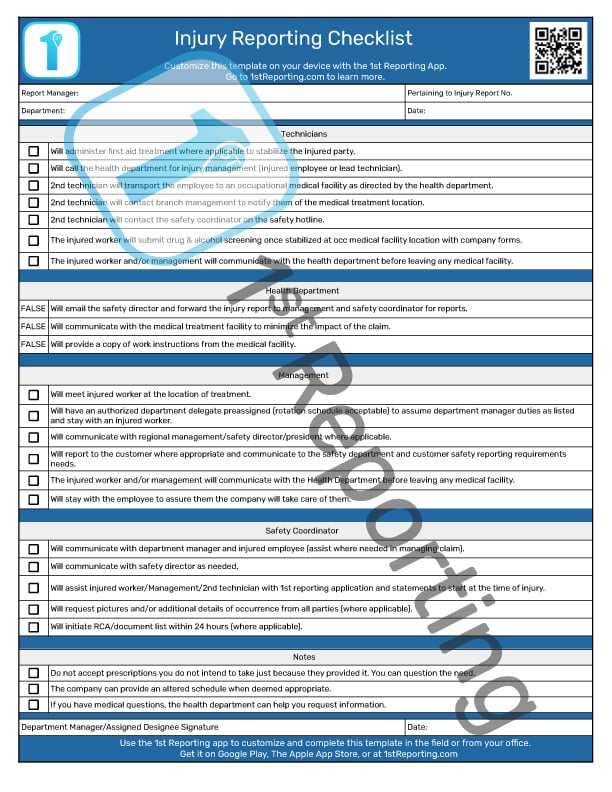As a manager in the manufacturing industry, your top priority is ensuring the well-being of your employees. You must also comply with the regulatory requirements for your business’s smooth operation. However, you need to leverage technology to improve your reporting processes to achieve optimal productivity and efficiency.
Real-time reporting is essential for identifying and mitigating potential hazards before they escalate into major incidents. Furthermore, real-time reporting helps increase operational effectiveness by preventing equipment breakdown and production stoppages through data-backed, educated decision-making processes.
In this article, we’ll discuss the importance of real-time reporting in manufacturing and how to implement it using a digital reporting platform to transform your operation into a safer and more efficient workplace.
The Importance Of Real-Time Reporting In Manufacturing
Downtime is the enemy of the manufacturing sector, and for a good reason. Rockwell Automation states, “… downtime costs heavy industry anywhere from five to twenty percent of productive capacity.”. But it isn’t just heavy industry that’s affected negatively. Every enterprise with any type of manufacturing or production will feel the burn of wasted labor expenses as employees sit around waiting to get back to work while you pay them to sit around and wait.
How do we defeat downtime? By creating efficient systems and solutions to mitigate downtime potential. Implementing real-time reporting into your day-to-day operations is one of the best actionable defenses.
What Is Real-Time Reporting

Real-time reporting in the manufacturing sector refers to capturing and processing operational data at the moment as events occur on the factory floor. This approach involves using digital tools and technologies like 1st Reporting to collect, store, and analyze data. This methodology allows manufacturers to gain immediate insights into their operations and respond to issues quickly.
Real-time reporting enables manufacturers to identify and address problems as they get reported, reducing downtime, improving quality, and optimizing efficiency. By providing visibility into the manufacturing process, real-time reporting also enables manufacturers to make more informed decisions and proactively address potential issues before they become escalated problems.
Why Real-Time Reporting Is Critical For Safety Managers In The Manufacturing Industry
The importance of real-time reporting in manufacturing can not be understated concerning the safety of your workforce. Packaging machines and other automated, moving mechanical creations power our modern manufacturing world. The equipment can pose extreme dangers to the most competent team members and technicians, so safety procedures are more critical than ever.
You could say that the relative importance of safety has increased with technology and our education as a modern and civilized society. Gone are the days of barbaric manufacturing practices as we enter the new world of artificial intelligence and automation, with all the risks and safety hazards it presents. Real-time reporting is more important than ever for maintaining a safe and functional workplace.
Benefits Of Real-Time Reporting

The benefits of real-time reporting are many, but four are of utmost importance to me.
Faster Response Times
The first and most critical feature of real-time reporting is improving incident response time. Let’s look at an example application of real-time reporting in a manufacturing environment.
Mark, the safety manager at a large manufacturing plant, was notified via his digital reporting platform of an incident on the factory floor. An operator had reported smelling gas near one of the production lines. Mark knew gas leaks could pose serious safety risks, so he immediately accessed the platform’s real-time reporting dashboard to assess the situation.
With just a few clicks, Mark could view data from the report completed on the facility floor, which showed a spike in gas levels in the area where the operator had filed the report in the north campus building. He quickly connected the report to an urgent maintenance team request and instructed them to shut down the production line and investigate the source of the leak.
Thanks to the real-time reporting capabilities of the digital platform, 1st Reporting, Mark and his team responded quickly to the incident, preventing a potentially dangerous situation from escalating. The maintenance team identified and fixed the leak within a matter of hours, and production was able to resume with minimal downtime.
Mark later reflected on how the incident could have been much worse if not for the real-time reporting capabilities of 1st Reporting. He knew that without the instant notification and access to accurate, up-to-date data, it could have taken much longer to identify the problem and take corrective action, putting the safety of the plant’s employees at risk.
Overall, Mark was grateful for the benefits of real-time reporting in manufacturing and was confident that the digital platform would continue to help his team stay ahead of potential safety hazards in the future.
As you can see in the example, a real-time reporting platform can make the difference between a simple risk assessment report and a disaster.
Better Data Accuracy
Have you ever tried to read a doctor’s writing? I don’t know if they teach them to write badly in school, but in my experience, you need a Ph.D. to understand a doctor’s writing. However, in defense of all doctors who maintain good writing practices and legibility, I’d like to point out that I once worked with a service technician who wrote worse than any doctor I’d ever met. Although he was a genius regarding relay logic and motor controls, he couldn’t write to save his life.
When utilizing a real-time reporting system like 1st Reporting, you don’t have to worry about poor writing performance. Instead, you’ll only suffer from your team member’s poor spelling or grammar, but at least you’ll be able to read and make sense of it. What does this mean? It translates to better data accuracy.
Utilizing Global Positioning Systems, our platform delivers a simple yet intuitive report management dashboard with multi-view report mapping. In other words, you can easily see where your team submits reports giving you complete clarity of all your facilities or locations.
Improved Decision-Making
I don’t need to tell you that real-time access to reports and data provides a more ideal, more educated environment for decision-making. When you get an instant notification telling you one of your team members finished a report, you also get instant access to the report. This instant communication improves disclosure and communications, allowing you to make more informed and improved decisions for your operation.
Real-Time Reporting In Action
Let’s take a look at a possible example of real-time reporting in action in a manufacturing facility.
Samantha was the safety manager at a large industrial plant. One afternoon, she received a notification on her phone from the digital reporting platform the company had implemented. The notification alerted her to a safety incident that had just occurred on the factory floor. A worker had been injured while operating a piece of packaging machinery.
Samantha quickly accessed the platform’s real-time reporting features, which provided her with a detailed report of the incident. She could see which machine the worker had been using, the type of injury sustained, and even a video recording of the incident captured by a nearby team member who completed the report.
Using the platform, Samantha immediately notified the company’s emergency response team and provided them with all the information they needed to respond quickly to the scene of the incident. They arrived on the scene within minutes and offered medical assistance to the injured worker.
Thanks to the real-time reporting capabilities of the digital platform, Samantha and her team responded quickly and effectively to the incident, minimizing the impact on the injured worker and preventing the situation from escalating further.
Again, you can see the virtues of real-time reporting concerning dealing with incidents; it’s second to none. For managing inspections, I can’t think of a better solution. However, let’s look at some traditional ways of managing reporting in manufacturing, from incidents to inspections. Maybe the past can tell us what we should expect from the future. Let’s find out.
Challenges Of Traditional Reporting Methods In Manufacturing

Paper-Based Reporting Limitations And Drawbacks
Let’s look at some of the limitations and drawbacks of old archaic paper-based reporting systems.
Paper-Based Reporting Limitations
Limited Accessibility
Your team may find paper-based reports challenging to access and share, especially when they are stored in multiple locations or require physical transport. If your teams are remote, or you use numerous facilities or have multiple job sites or locations, then access can be a problem.
Prone To Errors
Paper-based reports are more susceptible to incomplete or illegible information, incorrect data entry, or document loss. Using the 1st Reporting platform, you can rest easy knowing that our secure cloud-based reporting experience is backed up on the cloud, so it doesn’t matter what happens to devices. As long as the reports are submitted to the system, you’ll never lose them again.
Time-Consuming
“The man whose life is devoted to paperwork has lost the initiative. He is dealing with things that are brought to his notice, having ceased to notice anything for himself.”
C Northcote Parkinson
Collecting, organizing, and analyzing paper-based reports can be time-consuming, taking valuable time away from other tasks. I bet you’ve got more important things to do than sift through mountains of inspection or incident reports.
Limited Data Analysis
Paper-based reports are often limited in how they allow you to review quickly and effectively, preventing timely decision-making and issue resolution. You have to wait for the paperwork submission. If field teams neglect to submit reports, you might wait days before knowing of operational deficiencies. Can you afford to wait for the paperwork? Do you like having limited data available at any given time?
Paper-Based Reporting Drawbacks
Reduced Accuracy
As mentioned, paper-based reporting is prone to errors and omissions, which can lead to inaccurate reporting and decision-making. The reduced accuracy can cost your organization dearly.
Increased Risk Of Loss
Paper-based reports can be easily lost or damaged, leading to a loss of critical data and potentially causing delays or other issues. If you don’t have the data you need to identify potential problems, you’ll have difficulty trying to prevent them. That equates to an increased risk of loss in safety and operational effectiveness. You’re welcoming downtime and higher costs when you increase your reporting risk.
Limited Collaboration
Paper-based reporting is difficult to share and collaborate on, leading to siloed information and limited communication. Increased collaboration with digital tools like Microsoft Teams® (compatible with 1st Reporting) allows you to improve operational efficiency exponentially.
Delayed Response Times Mean Missed Opportunities
Every time you wait for a report, every time you wait to review inspection notes, you miss opportunities to act quickly and decisively. Missed opportunities to act to prevent hazards can cost you more than your job, reputation, and possibly freedom. It could cost someone their life. That’s why moving to a digital reporting platform like 1st Reporting is one of the most intelligent decisions you have ever made.
Regulatory Compliance Issues
One of the critical problems arising from using paper-based reporting systems is dealing with regulatory compliance promptly. Sure, you can sit around and wait for paperwork submissions. Sure, you can hope the paperwork has appropriately legible writing. And yes, you can even sit back and hope every part of your report template is adequately completed.
You could also buy a lottery ticket if you’re feeling lucky.
Regarding regulatory compliance, I don’t put my faith in luck. I put my trust in reliable reporting and report analysis – both of which are made possible with 1st Reporting, the industry standard for reporting software for industry.
Risk Of Non-Compliance And Legal Repercussions
You know what will happen if regulatory compliance issues go unresolved. You know that as a manager, you can be held accountable for the safety of those under your supervision. And the last time I checked, ignorance was not an excuse a manager could get away with. Remember, it isn’t just your ability to get away with some shady management practices or not. It’s about ensuring your team members make it home to their families safely at the end of their shift, preferably in one piece.
How A Digital Reporting Platform Can Improve Real-Time Reporting In The Manufacturing Environment

Overview Of The 1st Reporting Platform: An Industry Standard
By now, you should understand your facility’s needs in terms of reporting incidents and inspections. Furthermore, it would be best to understand that moving from a paper-based reporting system to a digital one is inevitable. After all, your competition is likely doing the switch, so do you want to let them get the operational advantage?
Our team of professionals at 1st Reporting is building a system to be proud of – a reporting platform that finally solves the inadequacies of paper-based systems while providing unsurpassed support at industry-leading competitive rates.
1st Reporting is the industry standard and platform of choice for municipalities, utilities, and field service organizations. Still, it’s fast becoming the standard in the manufacturing sector for its versatility, automation, and customization features. After all, paper-based reports can’t send customized notifications and reports, nor can they force a user to complete a field before moving on to the next – but 1st Reporting can.
Benefits Of Digital Reporting
We’ve talked about the limitations and drawbacks of paper-based systems. We’ve mentioned the advantages of using a digital reporting platform like 1st Reporting instead of traditional paper reports. However, let’s quickly review the benefits of real-time reporting for your business.
Real-Time Data Capture
Digital reporting platforms like 1st Reporting do more than allow you to create customized reports. They let your team capture real-time data, including inserting audio, video, and other multimedia. There isn’t a paper form in the world that can take a video, is there? Real-time data capture that includes media is the robust future of reporting. After all, if a picture speaks a thousand words, what does a video say?
Instant Notifications Equates To Instant Educated Decision Making
In the past, we had to rely on the speed of paper report delivery. Sometimes that meant as much as a day or two before a report made it to your desk. Well, waiting doesn’t do much to help the informed decision-making process, not when it’s the data you need to make the decision that you are waiting upon.
Digital reporting platforms let you make informed decisions at the speed that you can review data. That means it eliminates the waiting time for you to have the ability to review said data. With digital reporting systems like 1st Reporting, you can get the report the moment your team completes it – even if they are far away at a remote facility.
Increased And Improved Collaboration
Collaboration is at the heart of any efficient enterprise. Team members must have robust communication solutions regarding safety, or accidents quickly start piling up.
In the interest of workplace safety, it is critical that your team communicate risks and observed hazards quickly and truthfully. Using a digital reporting platform is the preferred means of achieving this goal. After all, you want to get the information soon to decide the next steps and take action. With a digital reporting platform, you can connect reports, elevate importance, and notify the right individuals, all within seconds and at the press of a button or two.



